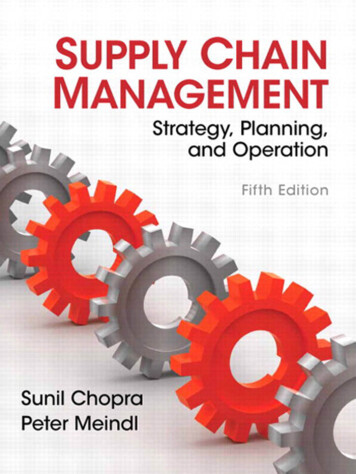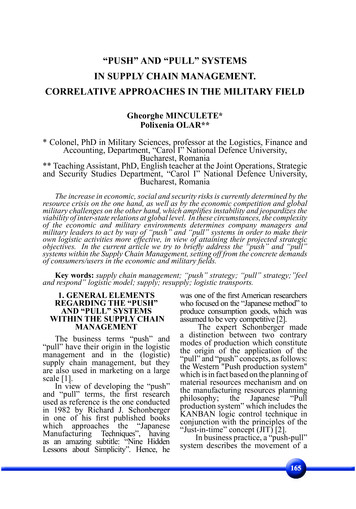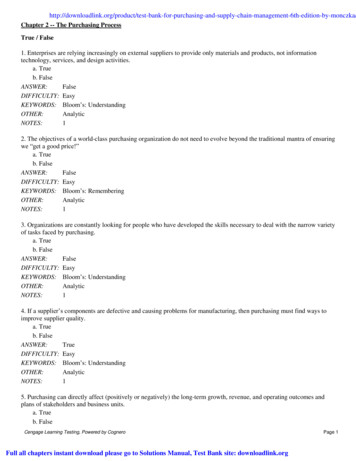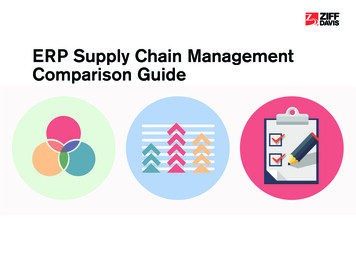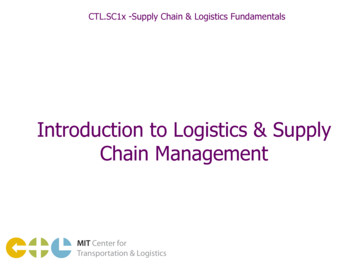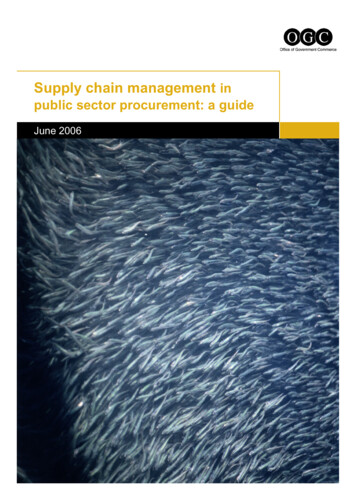
Transcription
Supply chain management inpublic sector procurement: a guideJune 2006
Contents2Page1Outline of this guide52What is Supply Chain Management?73Why is Supply Chain Management important?94What do Supply Chains look like?145When to consider Supply Chain Management176Background337Consultation368Related links379Terminology42
Supply chain management in publicsector procurement: a guide1. Outline of this guideWhat do we mean by supply chain management?In the context of this guide, supply chain management is concerned with the “coordination of all parties involved in delivering the combination of inputs, outputs oroutcomes that will meet a specified public sector requirement.”Purpose of this guideTo provide a series of key insights into the management of multi-tiered supplyrelationships within the government procurement environment. The aim is toencourage contracting authorities to take a more sophisticated approach to supplychain management and understand both the role that they and their mainsuppliers must play in managing the supply chain.Target audienceSupply chain management needs consideration at a strategic level and the targetaudience for this guide is primarily those who take strategic decisions onprocurements, programmes and projects in both central government and thewider public sector. In addition, those who implement such decisions will find thisguide useful, including individuals involved in contract, commercial and suppliermanagement as well as project and programme managers.This guide signals a change in attitude to management of the supply chain in thepublic sector and its messages are also targeted at suppliers to the public sectorKey messagesStrike a balanceEffective supply chain management is a question of allocating management of thesupply chain to the parties best placed to understand and co-ordinate theactivities of organisations involved in contract delivery. Just as a contractingauthority should not automatically seek to manage the entire SC itself, theauthority should not assume that transferring the whole responsibility for thesupply chain to a sole party will automatically deliver the most benefit.Wider benefitsIncreased openness, transparency and efficiency in the management of publicsector supply chains can offer benefits to all parties involved in delivering publicservices. In particular:3
4For contracting authorities:– Improved ability to identify strengths, weaknesses, opportunities andthreats in their supply chains.– Increased value for money and efficiency.For existing/potential subcontractors:– Better visibility of the routes available to gain access to opportunities inthe public sector.– Improved communications with contractors and, where appropriate,public sector clientsFor main contractors:– Improved early and ongoing communications with public sector clients.– More competitive subcontractor base offering better skills, expertise,innovation and value for money.
2. What is supply chain management?5There is no commonly accepted definition of supply chain management - it meansmany different things to many different people and numerous, overlappingdefinitions exist. This guide presents its own high-level definition that sets theconcepts within the specific context of public sector procurement.The supply chain is the combination of allparties (e.g. external suppliers, partnerorganisations, internal corporate services units)both inside and outside the organisation,involved in delivering the inputs, outputs oroutcomes that will meet a specified public sectorrequirement.Related LinkInput/Output/Outcome are definedin the Risk Allocation Model IntroductionSupply chain management is the co-ordination of all of these parties.The supply chain may be inbound into the public sector – an operationalrequirement for internal customers for example, or it may be outbound from thepublic sector – in place to deliver wider organisational objectives to provideservices for delivery to citizens, or a combination of both. This relationship ishighlighted in Figure 1.1.2Internal CustomerINPUTOUTPUTOUTCOMEINBOUND SUPPLY CHAINOperationalobjective e.g. newIT system tosupport HR servicedelivery, officebuilding foremployeesSSDELIVERINGSSDELIVERINGS1.1SExternal CustomerINPUTWider, externalobjective e.g. teachingmaterials to student,training for unemployedperson to help them getback to workOUTPUTSSOUTCOMEOUTBOUND SUPPLY CHAINS SupplierFigure 1: Inbound and outbound supply chainsThe shape of the supply chain and the supply chain management processesemployed will vary considerably depending on a range of different considerations.What might be some of the different characteristics of supply chains (SCs) andsupply chain management (SCM)?
6SCs can be inbound to the public sector – suppliers delivering goods andservices into the organisation to support its operational objectives e.g. officefurniture provision for a public sector organisation.SCs can be outbound from the public sector – directly supporting the meetingof end customers’ needs e.g. suppliers delivering public sector-funded externaltraining programmes to unemployed individuals to assist them in getting backinto work.SCs can be fully integrated, networks of interconnected companies withcommon performance and relationship management processes, or they couldbe characterised by arms length contractor-subcontractor relationships. Eachlink within the chain can differ in the nature of the interdependencies and theway in which the relationshipSCs can be long-term, strategic sets of relationships between multiple, diverseorganisations which are carried from project to project, or they can be ad-hocstructures established post-contract award to deliver a discrete, one-offThe focus of SCM can differ from government sector-to-sector. In the healthsector, the focus may be more on logistics and the effective movement of goodsand servicesin and out of hospitals whereas SCM in the education sector may focus onThe focus of SCM can differ from industry sector-to-sector. In construction,the focus is on the early establishment of a fully integrated client-supplier projectteam. In IT projects, the focus may be on building scope for innovation andflexibility into the SC to cater for changing requirements and rapidly evolvinginformation andFigure 2: Sample characteristics of supply chains & supply chain management
3. Why is supply chain management important?Supply chains and their associated management processes often remain invisibleto the public sector client. Government has traditionally focused on thecontracting process with first tier suppliers – the SC members with whom theprocuring organisation directly contracts. The 2004 PAC Report on ‘Improvingdepartments' capability to procure cost-effectively’ highlighted how only 17% ofdepartments, agencies and non departmental public bodies analyse theirsuppliers’ supply chains as part of their criteria for selecting suppliers and thussuffer from a lack of assurances about the reliability and resilience of their keysuppliers’ subcontractors.In September 2004, OGC undertook a survey of central civil government (CCG)departments and key suppliers to the public sector looking at activities andattitudes in relation to SCM. Several key figures reinforce the PAC Reportfindings:Whilst 94% of responding departments felt that maintaining details of mainsuppliers’ subcontractors was important, only 57% of respondents maintainedsuch information.68% of respondents did not know how their main suppliers advertisedopportunities to potential new entrants to the SC.Only 36% of respondents sought feedback from main suppliers’subcontractors during contract delivery.In addition, a 2004 survey conducted in the local government sector by IdeA toevaluate progress against milestones for the National Procurement Strategy forLocal Government identified that only:41% of councils report that they invite bidders for partnership contracts todemonstrate their track record in achieving value for money through their useof the supply chain, including use of small firms.28% of councils continue to examine suppliers’ use of the supply chain.39% track suppliers’ use of the supply chain in contract management.Whilst it is relatively common, especially in complex procurements, for the first tiersupplier(s) to manage the SC on behalf of the contracting authority, relatively littleeffort has been made by the public sector to improve its visibility of SCs and itsability to exert influence over how the first tier supplier(s) manages this chain,except perhaps in the construction industry.A number of public sector construction initiatives, including the Latham Report(Constructing the Team), the Egan Report (Rethinking Construction) and theGovernment Construction Clients’ Panel identified areas of poor performanceamongst suppliers and government clients. These initiatives have emphasised7
8the benefits of improving supply chain management throughout the entire supplychain, including closer supply chain integration. OGC’s Achieving Excellence inConstruction initiative, launched in 1999, provides a series of targets for improvingperformance of the government client, including SCM performance.The limited effort in other industries to improve supply chain performance couldbe for reasons of simplicity, resource constraints, a lack of understanding orperceived need for understanding, or perhaps even a perception on the client sidethat the policy and legal framework does not allow for such activities.Increasingly, the complexity of many contracts, a greater appreciation of the needto improve competition and innovation, and an increasing awareness of theimpacts of terrorism or natural disasters on SCs and business continuity, meansthat wider supply chain issues increasingly need to be taken into account inseeking improved efficiency and value for money. There are a number of aspectsof the current public sector procurement landscape that the public sector needs toconsider from the perspective of the whole supply chain rather than simplyfocusing on the first tier of suppliers:Implementation of the Government’s Efficiency Programme across the publicsector.Sustainable development and the role of public sector procurement as apossible lever for delivering wider policy objectives, for example, in areas suchas:– Innovation and the harnessing of new ideas in the public sector.– The promotion and maintenance of competitive and contestable markets.– Opportunities for diverse organisations such as SMEs, VCOs, BMEs,women-owned businesses and social enterprises, which includes the use oftechnology.– Achieving community benefits in local government through, for example,community benefit clauses.– Race and gender equality.– Promotion of skills and training.The impact of increasing aggregation and bundling of public sector demandand/or supply.The increasing adoption of eProcurement tools and techniques.The areas highlighted above represent wider policy considerations from whichcontracting authorities can achieve both the benefit of increased value for moneyand efficiency and also, in the case of sustainable development, the benefitsassociated with delivering wider objectives through procurement.
9In developing a whole SC perspective in these areas, it is important to find theoptimum balance between accountability and influence of the contractingauthority and the efficiencies delivered by the first tier supplier(s), whosecompetitive advantages are often strengthened by the efficiency andeffectiveness of their supply chain management processes.In striking this balance, there are ways in which authorities can develop their ownapproach to SCM and promote good SCM practice outside of individualprocurements, for instance by encouraging the first tier supplier(s) to consider theinvolvement of SMEs, VCOs, BMEs, women-owned businesses and socialenterprises where they can offer particular benefits.Related linksGuidance on the benefits that a range of different organisations can offer tothe public sector and how they can be encouraged through the supply chain:Smaller supplier better valueThink Smart Think Voluntary SectorSocial enterprise: a strategy for successBlue Frog 2: a guide to e-procurement for the public sectorPublic procurement: A toolkit for Social EnterprisesThere is a strong body of academic and practitioner-based evidence that goodpractice in SCM can benefit all participants in the procurement process. Thisguide will focus on the benefits of improved supply chain management for thepublic sector.Benefits of supply chain managementThere are a number of clear benefits to contracting authorities of improvedefficiency and transparency in the managementof public sector supply chains:Related linksBetter risk allocation. In an increasinglycomplex delivery landscape, effective riskallocation is a critical consideration inprocurement. Risk should always beallocated according to the party best placedto manage it, and a better understanding ofthe way in which the requirement can bedelivered allows the authority to assess howRisk Allocation Model – Part 3:Project strategyManagement of Risk – Principlesand Concepts (The Orange Book)Managing Risks with DeliveryPartners
10risk can be allocated across the SC and howthey can be managed most effectively.Greater visibility of subcontracting opportunities for a diverse range oforganisations who can bring increased competition, dynamism and particularskills or strengths to the public sector, including organisations such as SMEs,VCOs, BMEs, women-owned businesses and social enterprises. This canincrease competition and allow organisations with particular skills or strengthsto get involved in the public sector marketplace.Greater opportunities for innovation.Supplier innovation in the SC cancontribute to better quality, faster deliveryand reduced whole life costs. EffectiveSCM offers strong potential for innovationto be released through the supply chain. Ajoint initiative between NHS Estates andthe DTI has been established to identifyhow to harness innovation in the supplychain in healthcare construction.Related linksCapturing Innovation – Nurturingsuppliers’ ideas in the n in HealthcareConstructionBetter-defined requirements through early supply chain involvement in theshaping of the business need. This could be through market sounding forexample. The case for early SC involvement is likely to be stronger in outputor outcome-based approaches or where the requirement is complex orinnovative. Involvement of the SC at an early stage can be vital inestablishing the right requirements and the approach to meeting them.Improved ability to identify risks or bottlenecks in contract delivery throughgreater authority awareness of exactly how the contract is going to beimplemented and of the key SC dependencies.Better quality solutions offered by suppliers as opportunities can be moreeasily identified in their supply chains to improve quality, increase deliverytimes and reduce costs.These benefits can lead to increased value for money and efficiency for anindividual contracting authority. There are also wider benefits for the public sectoras a whole:SCM can contribute to improved long-term sustainability and better capacitymanagement of supply markets through the availability of a more competitiveand diverse supply base at subcontractor level. OGC is undertaking aprogramme of work looking specifically at increasing competition andimproving capacity planning in the government market place and SC analysisis a component of this programme.
11More effective use of the SC contributes to the wider agenda of improvingefficiency and value for money in the public sector’s commercial activities, bypromoting competition, not just at first tier supplier level, but across the widersupply base and also encouraging more efficient management of suppliers.It is important that the authority takes appropriate steps to ensure that the first tiersupplier(s) have the capability to manage their SCs to the ultimate customer’sbenefit, and to deliver value for money in public sector contracting.
124. What do supply chains look like?Each SC has its own individual characteristics according to a wide range ofdeterminants e.g. degree of complexity of requirement, length of contract orproject, relative buyer-supplier power, different supplier relationships or riskallocations. In many cases, each individual link in the chain between one ormany organisations may have different characteristics. This guide does not seekto map individual SCs and their links. The contracting authority needs to map itsown SCs and develop an understanding of each individual scenario.SCs in large-scale procurement activities can often be very complex, with multipletiers and many, diverse types of organisations involved in delivery. The followingsection is intended to present a clear and simple analysis of some of the differenttypes of SCs that might be employed in public sector procurement. In reality, thepicture for an individual SC may be much more complex, with multiple supplychain tiers and further supply chains at lower tiers. Many modern, commercialsupply chains are in fact characterised by networks of interconnected firms ratherthan simple contractor-subcontractor relationships.In the construction industry, an integratedproject team approach is commonly employed,which brings together multiple, integratedsupply chains into one supply team that isthen integrated with the client project team.This structure supports the management ofthe complex SCs often employed in majorconstruction projects.Related linkAchieving Excellence inConstruction – AE5: Theintegrated project team:teamworking and partneringThe good principles of integrated project teams, as established in AchievingExcellence in Construction for example, are also applicable outside theconstruction sector, especially in large-scale procurements with complex supplychains (refer to page 29 for more details).In some cases, the contracting authority may feel that it is in a position to activelymanage the entire SC, contracting directly with all parties involved and coordinating their activities where necessary. This approach, highlighted in Figure 3,can provide a much greater degree of control over the parties involved in contractdelivery but has strong demands for the skills and resources within the ingAuthoritySupplierSupplierSupplierSupplierFigure 3: Supply chain managed by contracting authority
13In other cases, the contracting authority may choose to contract directly with a keysupplier who will manage subcontractors, but also intervene at a particular point intheir SC where it can achieve a specific benefit e.g. in leveraging buyer power toachieve a better deal on an input. However, such an approach could haveimplications on the existing power relationships between suppliers and the powerbalance in the SC. For example, traditional industry alliances between suppliersmay be impacted by the authority’s intervention. An example of this approach ishighlighted in Figure 4.Contracting AuthorityDirectInterventionSecond tiersupplierFirst tiersupplierSecond tiersupplierSecond tiersupplierFigure 4: Supply chain intervention by contracting authorityA common arrangement is one in which the responsibility for constitution andmanagement of the SC is awarded to a main supplier(s) who will then manage theother suppliers involved in contract delivery on behalf of the contracting authority.This approach is highlighted in Figure 5.Contracting AuthorityFirst tier supplier: SupplyChain ManagerSecond tiersupplierSecond tiersupplierFigure 5: Supply chain management by first tier supplierSecond tiersupplier
14The benefit of the approach highlighted in Figure 5 is that it allows the contractingauthority to transfer a large degree of responsibility to a main contractor. Itprovides a clear line of accountability and can often relieve the contractingauthority of a potentially complex integration task. This structure is particularlycommon in prime-type contracting arrangements, in which a single supplier isappointed to manage the SC on behalf of the contracting authority. In addition, arange of other procurement approaches including, for example, PFI or the use ofFramework Agreements for goods and services, will often be implemented in away that provides a sole point of entry to the SC for the contracting authority.This approach can potentially mean that the authority loses influence and visibilityof the activities of those suppliers in the SC with which it does not directly contract.The opportunity for more active management of all suppliers in the SC canbecome limited and the SCM capabilities of the main contractor(s) will beincreasingly important.
5. When to consider supply chain management1. Outside a procurementThere is considerable scope for encouraging improved competition andperformance in public sector supply chains outside an individual procurementcycle, where policy and legal obligations are not as prevalent as inside the cycle.The ‘Within an Individual Procurement Cycle: Supplier & ContractManagement‘ section of the guide (‘Influencing the First Tier – Options’, page 26)identifies a number of areas in which the first tier supplier(s) could be encouragedor supported in improving the management of their supply chains. Many of theseareas can be considered outside an individual procurement cycle, as part of awider improvement programme e.g. encouraging open, fair and transparentsubcontractor selection, developing structured relationship managementapproaches or developing policies on the use of SMEs, VCOs, BMEs, womenowned businesses and social enterprises.Improving management of the SC is much more than a technical procurementissue, it is a wider cultural issue related to the manner in which authorities and thesupply chain engage. The following section identifies some specific areas inwhich SCM should be considered outside of an individual procurement cycle.Self-assessmentAs a first step in developing a more sophisticated approach to supply chainmanagement, it is important that a contracting authority understands its owncapabilities in managing the supply chain. Whilst individual procurements anddecisions on the make-up and management of the supply chain should be treatedon a case-by-case basis, the authority must inform these decisions with anunderstanding of how well it is equipped to increase involvement and interactionswith the supply chain, and also how well equipped its suppliers are to manage thesupply chain.The role of an “informed” or “intelligent” customer function within an authoritycould be particularly important in assessing SCM capabilities. An “intelligent” or“informed” customer function will act as an interface between the customer andsuppliers. It will have an in-depth understanding of the authority and its businessas well as an understanding of the capabilities of suppliers. This understanding iscrucial in assessing an authority’s ability to increase its interactions with the SC.Teamworking and partneringThe public sector delivery landscape is an increasingly complex one, involving arange of different types of organisations and a range of different delivery methods.The role of the SC that underpins public service delivery and the balance between15
16management of the SC by the public sector client and management of the SC byother organisations will differ according to the delivery methods employed.One method that has wider implications on the SC is partnering – the delivery ofthe public sectors’ objectives through partner organisations. Partnering is aboutmuch more than individual procurement cycles, it is about a collaborative way ofworking based on teamworking, openness, communication, mutual trust andsharing information.Partnering necessitates a cultural change in the way that contracting authoritiesand suppliers engage, and it has clear implications on supply chain management.A closer relationship between the authority and its partners is likely to necessitatea re-definition of relationships in the supply chain. How will the principles of thepartnering arrangement be passed down the supply chain? Will the authoritybecome more involved in SCM as part of a more collaborative workingarrangement? How will risk be managed in the partnering arrangement and theSC?Related linksAchieving Excellence in Construction – AE5: The integrated project team: teamworking and partneringRisk Allocation Model – Part 3: Project strategyEffective Partnering – an overview for customers and suppliersManaging Risks with Delivery PartnersRisk Allocation in Long Term ContractsTwo way communicationsAs a major procurer with significant purchasing power in a number of key marketsectors, public sector clients should be leveraging their power to:Develop a better understanding of their key suppliers’ supply chains.Encourage better management of all suppliers.Communicate wider public sector expectations around market sustainability,competition and innovation.Improving ongoing two way communications with industry is an area in whichcontracting authorities can encourage better SCM. A number of governmentreports, including the Kelly report on capacity and competition and the RIU reporton reducing bureaucracy in government procurement, have emphasised thebenefits of ongoing communications with the supplier community in terms of
17better capacity management and improving the chances of success ofprocurement projects. Two way communications can also be applied to promotebetter management of public sector SCs.Two way communications is concerned not just with how the requirement isconveyed to prospective bidders, but also how engagement and consultation withsuppliers can be built into the formulation of clear and realistic procurementspecifications and outcomes. Involving suppliers, and potentially building strategicrelationships with “communities” of suppliers (as done by the Highways Agency,for example) allows continual assessment of supply capacity, checking oftechnical and operational viability, generation of new (and often innovative) ideas,and also helps to build trust between parties.Some examples of good early and ongoing supplier engagement practices are:Building a defined supplier management function within the contractingauthority. This function needs a clear brief to identify key suppliers and supplychains and to begin to understand the operation and management of theirbusinesses.Concept Viability is an approach used in the IT sector (and run by Intellect, thetrade body for that sector) which consults with technically relevant supplierson the technical and business case viability of new concepts before they enterthe Invitation to Tender phase. This approach gives an opportunity to developspecifications which are realisable.Building supplier communities or supply chains which meet frequently (incontrolled environments) to discuss and comment on authority procurements,policies and management, and gives an opportunity for contract managers tounderstand issues facing suppliers. These communities can be chaired bylead suppliers.“Selling to” events can be held to familiarise suppliers with the types ofopportunities available, how to bid for them, and how such contracts aremanaged (including quality of supply).Meet the Buyer events are held by contracting authorities via Business Linksand Chambers of Commerce to allow prospective suppliers to meet withprocurers. For example, the Strategic Rail Authority holds regular “suppliersurgeries.”Websites are an excellent opportunity to advertise opportunities, but also toseek input and views from prospective suppliers. Thought must be given tothe design of websites in order to create an effective communications channel.Promoting the use of the Senior Responsible Industry Executive (SRIE) role inprojects and programmes. In some examples, main suppliers to the publicsector have chosen to implement the SRIE role throughout the SC.
18Related linkSuccessful Delivery Toolkit provides guidance on the role of the SeniorResponsible Industry Executive:Senior Responsible Industry Executive roleContracting authorities as a “Bridge”Contracting authorities themselves can act as a “bridge” between the first tiersupplier(s) and the supply chain to improve visibility of subcontractingopportunities for potential new suppliers and to open new communicationschannels in the SC:Listing details of contracts and main contractors on their own websites. Thisis good practice identified by the BRTF and there is strong potential fordevelopment in this area. OGC’s 2004 SCM survey identified that:–Only 25% of central civil government procurers surveyed provide maincontractor details on their websites.–32% provide details of awarded contracts.–43% provide details of upcoming contracts.The IDeA 2004 survey of progress on milestones for the National ProcurementStrategy for Local Government identified that only 22% of responding localcouncils publish bidding opportunities on their website.Some good examples of websites that contain contracts information include:–Leeds City Council–Oxfordshire County Council–Highways Agency–HM Revenue and CustomsActing as a “dating agency” – an organisation that assists in bringing togetherthe first tier supplier(s) and potential subcontractors. Trade Local (apartnership between Haringey Council, Enfield Council, Middlesex Universityand Fit to Supply with match-funding from the European RegionalDevelopment Fund) hosted a networking event to bring together large
19construction contractors and smaller suppliers to explore local subcontractingopportunities.Establishing a communications channel e.g. contact telephone number,through which any subcontractors can report issues and concerns regardingmain supp
Supply chain management is the co-ordination of all of these parties. The supply chain may be inbound into the public sector – an operational requirement for internal customers for example, or


